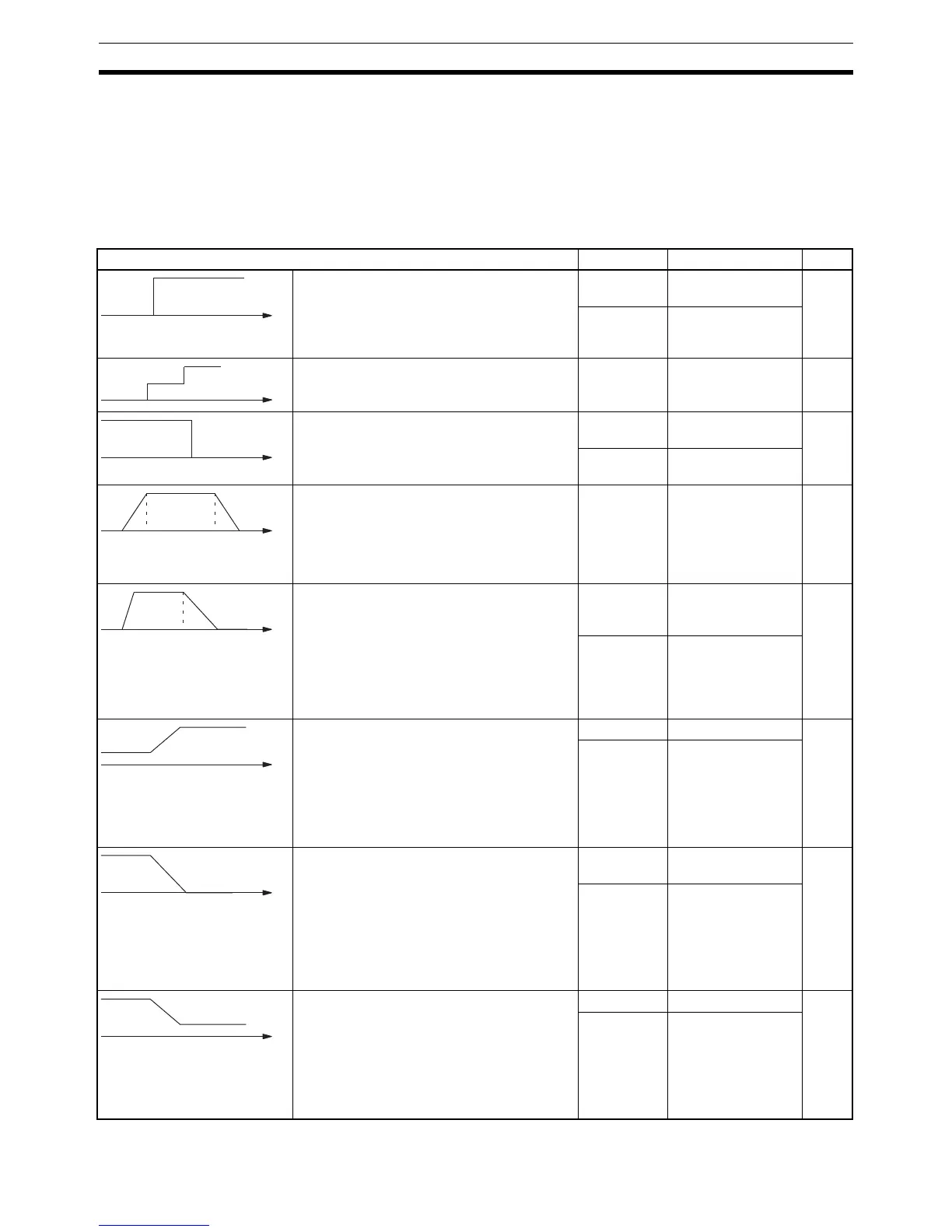106
Pulse I/O Board Section 2-2
Note Use INI(61) when pulse output has to be stopped immediately, as for an emer-
gency stop, etc. Pulse output will not stop even if a SPED(64), PLS2(––), or
ACC(––) signal turns input OFF.
Only stop pulse output when it is actually being output. Confirm the status of
pulse output using the Pulse Output In Progress Flag (AR0515/AR0615).
The following table shows the types of frequency changes that can be made
with combinations of PULS(65), SPED(64), INI(61), PLS2(––), and ACC(––).
Frequency change Instruction Operand settings Page
Start pulse output at the specified frequency.
Execute PULS(65) followed by SPED(64).
PULS(65) CW/CCW
(Number of pulses)
111
SPED(64) Port
Continuous/Inde-
pendent Frequency
Change frequency by steps during pulse out-
put.
SPED(64) Port
Continuous/Inde-
pendent Frequency
Stop pulse output with an instruction.
Execute SPED(64) or INI(61).
SPED(64) Port
Frequency= 0
113
INI(61) Set control data to
stop pulse output.
Outputs a specified number of pulses. The
pulse output accelerates to the target fre-
quency at a specified rate, and decelerates
to a stop at the same rate.
PLS2(––) Port
CW/CCW
Acceleration/Decel-
eration rate
Target frequency
Number of pulses
114
Outputs a specified number of pulses. The
pulse output accelerates to the target fre-
quency at a specified rate, and decelerates
to a stop at another specified rate.
ACC(––) instruction mode 0: Acceleration +
Independent Mode
Execute PULS(65) followed by ACC(––).
PULS(65) CW/CCW
Number of pulses
Deceleration point
115
ACC(––)
(Mode 0)
Port
Acceleration rate
Target frequency 1
Deceleration rate
Target frequency 2
Accelerates pulse output from the current
frequency to the target frequency at a speci-
fied rate.
Pulse output will continue.
Execute PULS(65) followed by ACC(––).
ACC(––) instruction mode 1: Acceleration +
Continuous Mode
PULS(65) CW/CCW 115
ACC(––)
(Mode 1)
Port
Acceleration rate
Target frequency
Decelerates pulse output from the current
frequency to the target frequency at a speci-
fied rate.
Pulse output will stop when the specified
number of pulses have been output.
Execute PULS(65) followed by ACC(––).
ACC(––) instruction mode 2: Deceleration +
Independent Mode
PULS(65) CW/CCW
Number of pulses
116
ACC(––)
(Mode 2)
Port
Deceleration rate
Target frequency
Decelerates pulse output from the current
frequency to the target frequency at a speci-
fied rate.
Pulse output will continue.
Execute PULS(65) and then ACC(––).
ACC(––) instruction mode 3: Deceleration +
Continuous Mode
PULS(65) CW/CCW 116
ACC(––)
(Mode 3)
Port
Deceleration rate
Target frequency
